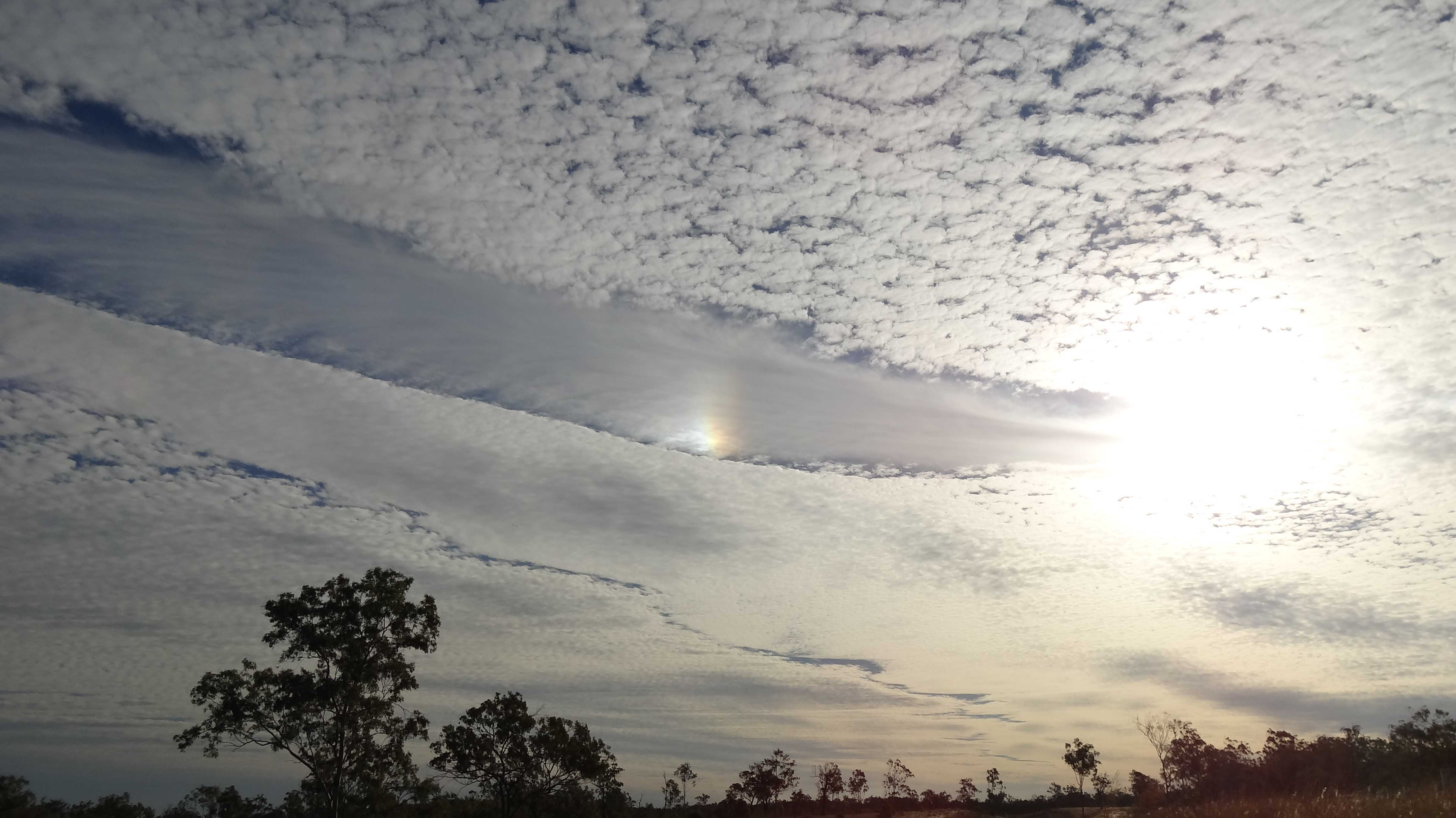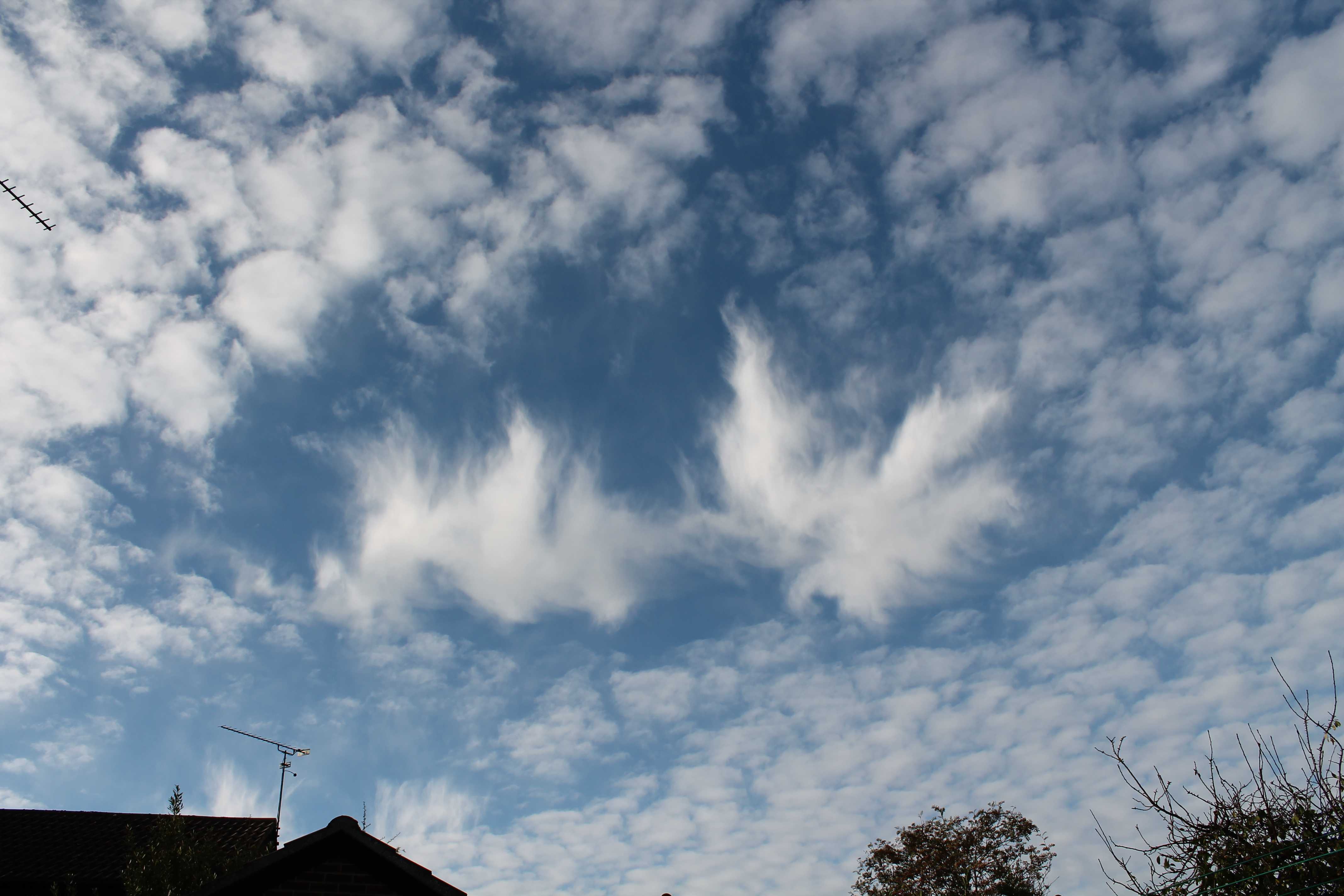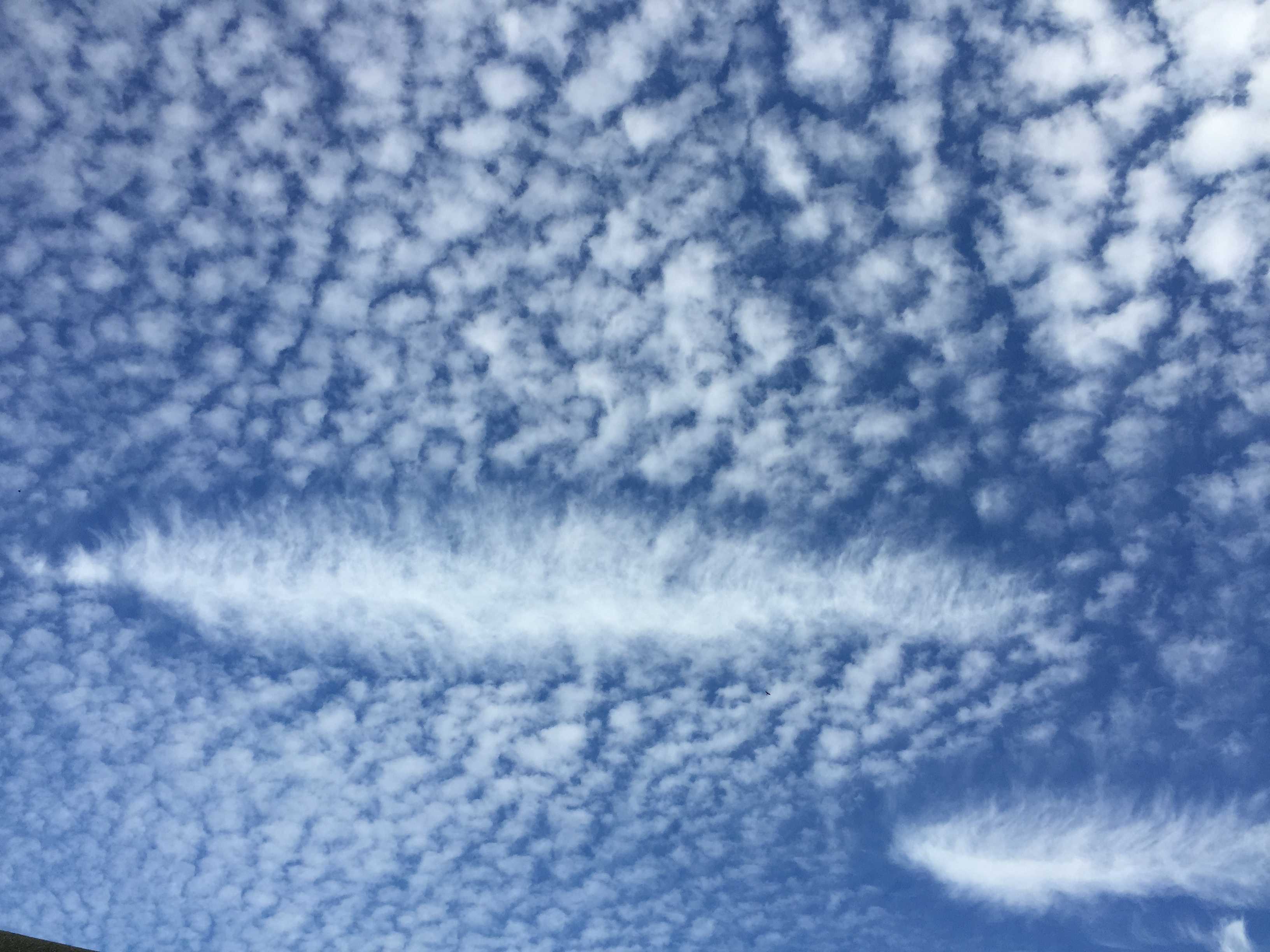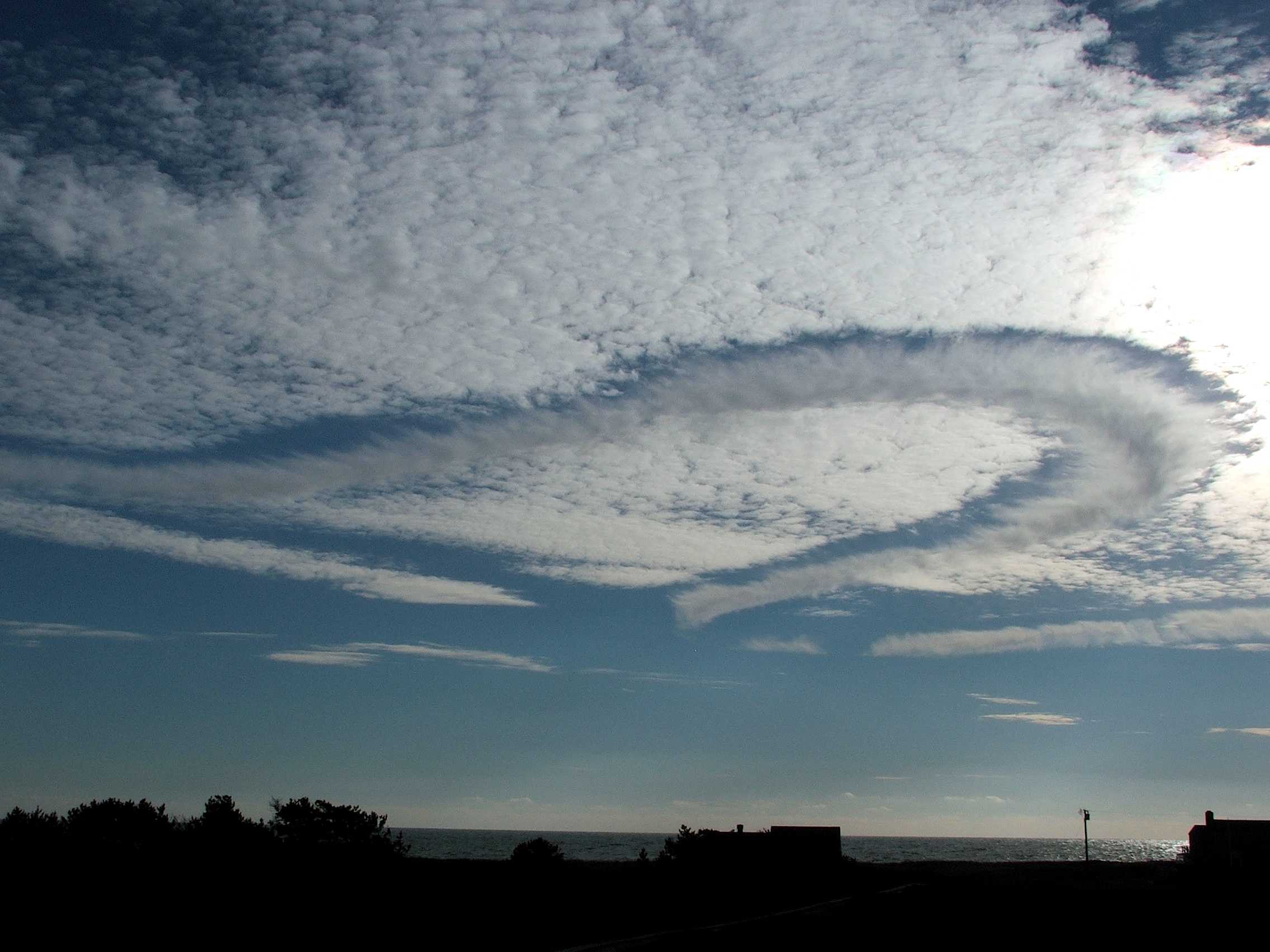© Tsz Cheung Lee
Kwun Tong, Hong Kong, China
Latitude: 22° 18' 41'' N
Longitude: 114° 13' 38'' E
19 January 2015 0830 (Local Time)
Camera direction: towards SW
Image P/S code: P.4.16
Image I.D.: 5167
CL = 0, CM = 3, CH = 0
-
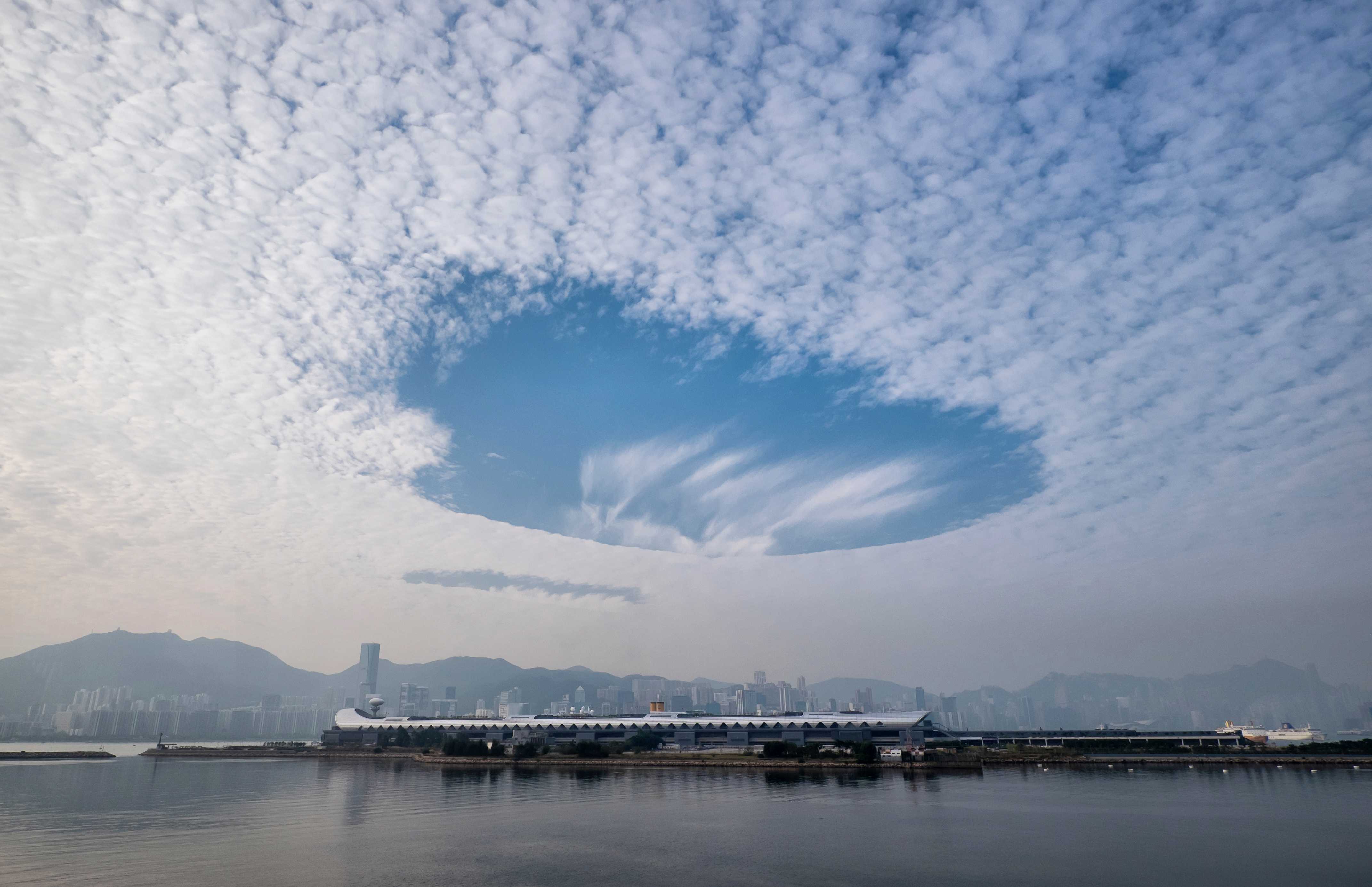
Altocumulus stratiformis perlucidus translucidus cavum
This thin, translucent and extensive layer of cloud is Altocumulus stratiformis translucidus. In the top part of the picture it also displays the variety perlucidus, as there are the gaps between the cloud elements. However, the most striking feature is the large, roughly circular hole beneath which there is virga. The large hole is the supplementary feature cavum, popularly known as a “fallstreak hole” or “hole-punch cloud”. The full classification for the cloud is therefore Altocumulus stratiformis perlucidus translucidus cavum.
Also of note is a linear gap in the cloud between the fallstreak hole and the horizon. This is an aircraft dissipation trail, or distrail, formed as a result of an aircraft flying through the cloud layer. Informally this is sometimes known as a “canal cloud”. It later transformed into a circular-type hole (see the accompanying time lapse).
The supplementary feature cavum is formed when glaciation occurs in a thin cloud layer consisting of supercooled water droplets that are in a liquid state and at a temperature below 0 °C. As the supercooled water drops glaciate, the resulting ice crystals fall from the cloud layer to a lower level as virga, or fallstreaks. The resulting cloud hole typically grows larger with time while the glaciation process continues.
Links in the image description will highlight features on the image. Mouse over the features for more detail.
© Tsz Cheung LeeKwun Tong, Hong Kong, ChinaLatitude: 22° 18' 41'' NLongitude: 114° 13' 38'' E19 January 2015 0830 (Local Time)Camera direction: towards SWCL = 0, CM = 3, CH = 0Image P/S code: P.4.16Image I.D.: 5167 © The Government of the Hong Kong Special Administrative Region
© The Government of the Hong Kong Special Administrative Region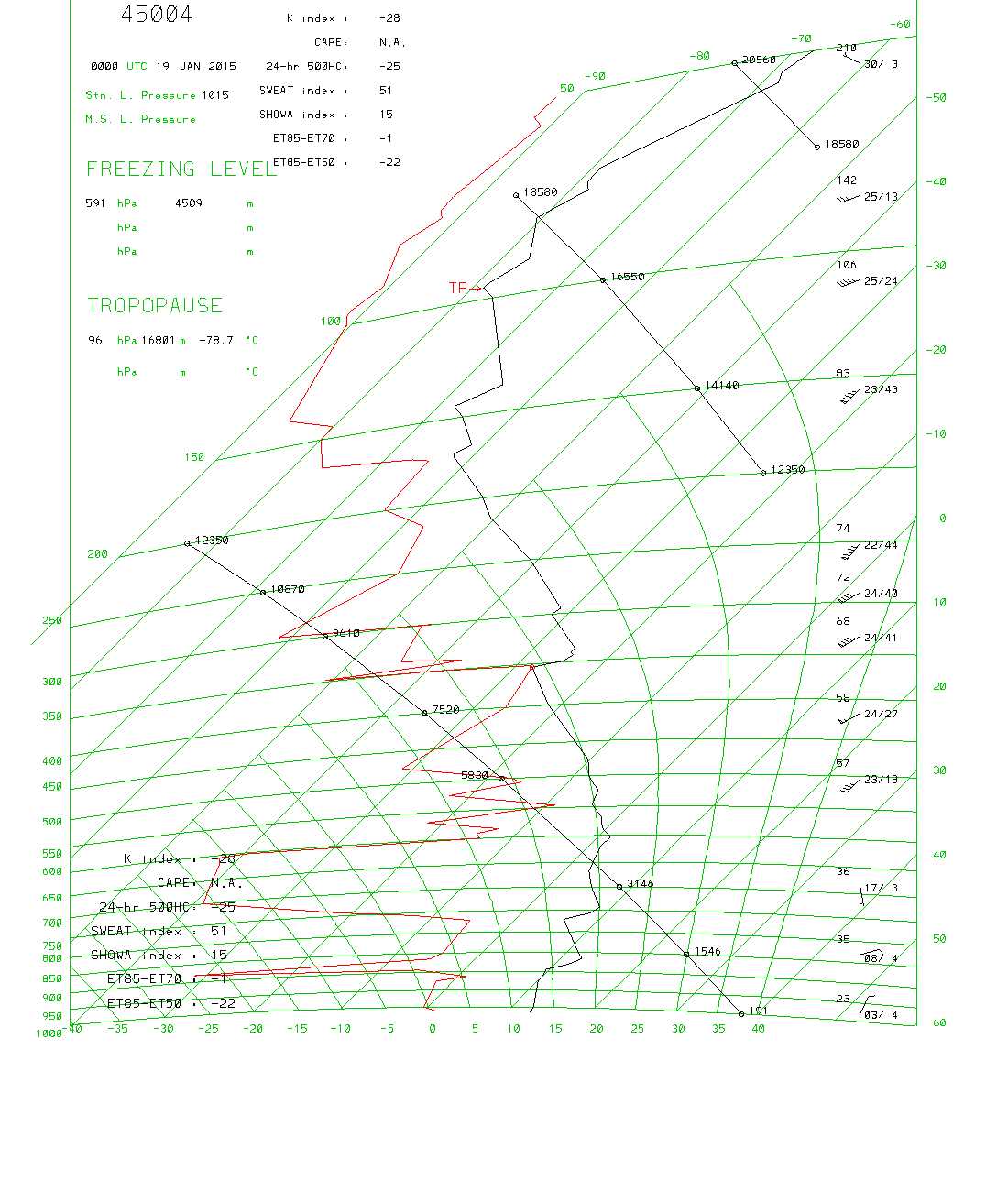 Upper-air sounding information obtained from King's Park, Hong Kong (China)© The Government of the Hong Kong Special Administrative Region
Upper-air sounding information obtained from King's Park, Hong Kong (China)© The Government of the Hong Kong Special Administrative Region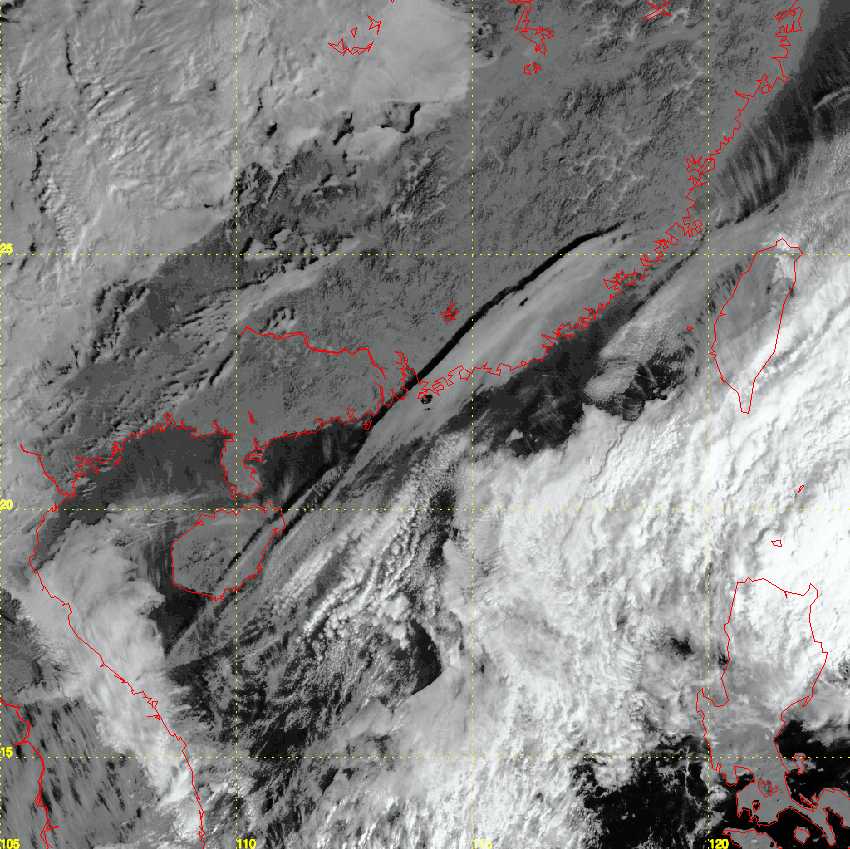 The satellite image shows an oval-shaped hole in the cloud layer over Hong Kong (China).© The Government of the Hong Kong Special Administrative Region
The satellite image shows an oval-shaped hole in the cloud layer over Hong Kong (China).© The Government of the Hong Kong Special Administrative Region
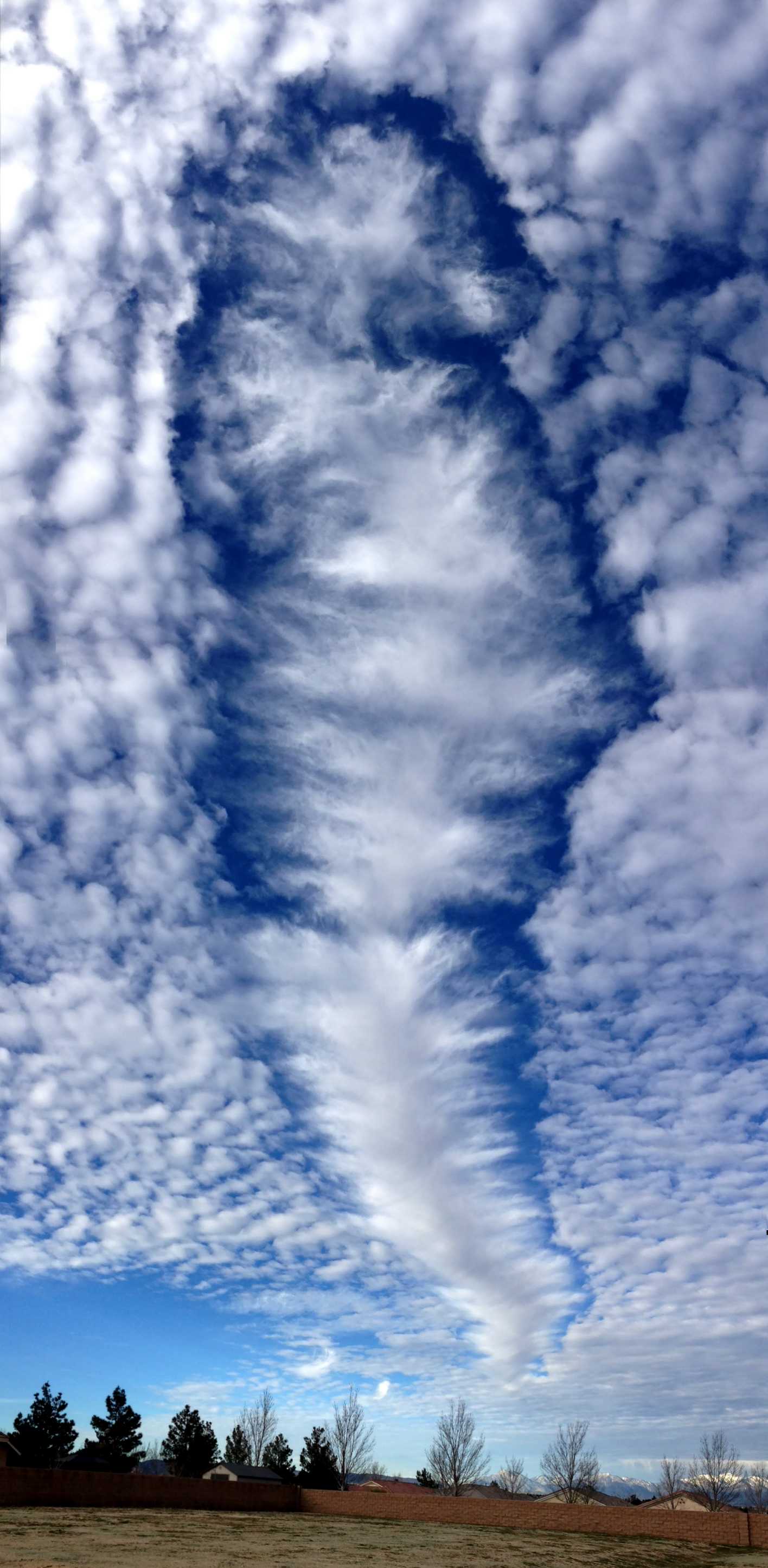
Altocumulus stratiformis perlucidus translucidus cavum
This picture shows Altocumulus stratiformis perlucidus translucidus cavum. In particular, this is the linear variant of the supplementary feature cavum, resulting from an aircraft dissipation trail through the cloud.
The medium-level cloud, Altocumulus, is in an extensive layer and so the species is stratiformis. It is thin and translucent, hence the variety translucidus, and the gaps between the cloud elements also indicate the variety perlucidus. Running through the cloud is an aircraft dissipation trail, or distrail (sometimes known informally as a “canal cloud”), which has widened over time to form the supplementary feature cavum. The Altocumulus layer consists of water droplets in a supercooled state at a temperature well below 0 °C. The interaction of the aircraft with the cloud has caused supercooled water drops to glaciate and to fall from the cloud as ice particles, hence the central line of ice fallstreaks along the distrail.
Links in the image description will highlight features on the image. Mouse over the features for more detail.
© Bobby BoytotApple Valley, California, United States of AmericaLatitude: 34° 27' 14'' NLongitude: 117° 13' 58'' W09 March 2014 0825 (Local Time)Camera direction: towards SECL = 0, CM = 3, CH = /Image P/S code: S.4.16 1Image I.D.: 4765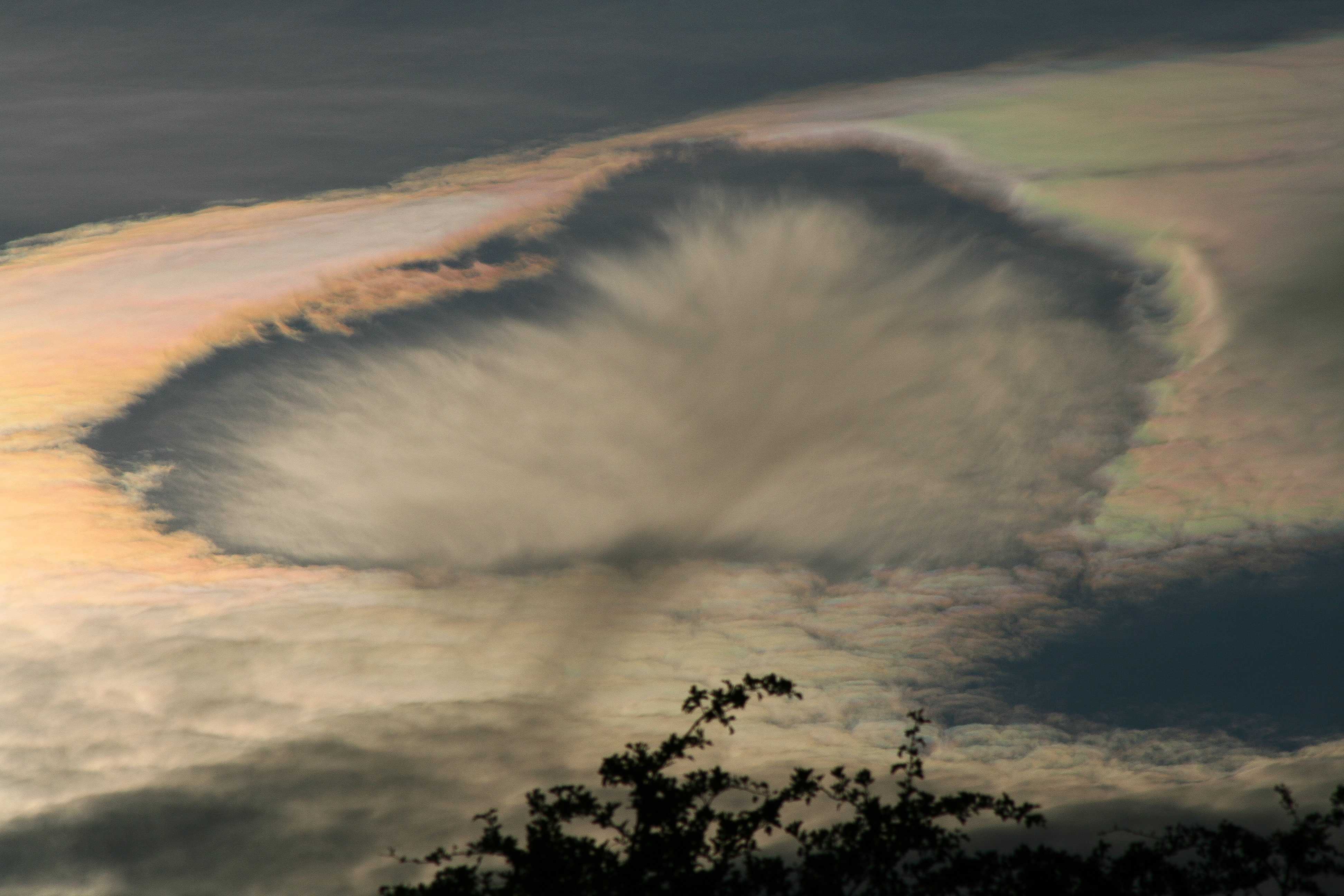
Altocumulus stratiformis translucidus cavum
This image shows a well-developed fallstreak hole in Altocumulus stratiformis. The hole (cavum), filled with ice crystals, formed over a period of 40 minutes and eventually became very large (40° angle of view) as it was blown from the north-west to the south-east. Note that the image has been slightly underexposed deliberately in order to show the irisation or iridescence on the cloud edges, in contrast to which the (ice crystal) virga, or fallstreaks, show as pale grey in colour. An older hole, in which the fallstreaks appear to have evaporated, can be seen at the lower right. Another layer of cloud (duplicatus) can be seen at the lower left of the image. Some higher Cirrus is at the top left.
The Altocumulus formed ahead of a warm front advancing from the north-west around a very deep (for mid-summer – 985 hPa) cyclonic centre located over Denmark, in a cool north-westerly airstream.
The supplementary feature cavum is formed when glaciation occurs in a thin cloud layer consisting of supercooled water droplets in a liquid state at a temperature below 0 °C. As the supercooled water drops glaciate, the resulting ice crystals fall from the cloud layer to a lower level as virga, or fallstreaks. The resulting cloud hole typically grows larger with time as the glaciation process continues. The ice crystals may fall into drier air, where they evaporate, and so the hole may eventually lose its central fallstreaks.
Links in the image description will highlight features on the image. Mouse over the features for more detail.
© Stephen BurtStratfield Mortimer, near Reading, England, United Kingdom of Great Britain and Northern IrelandLatitude: 51° 22' 12'' NLongitude: 1° 2' 24'' W26 June 2007 1908 (Local Time)Camera direction: towards WCL = 0, CM = 3, CH = 1Image P/S code: S.4.16Image I.D.: 4957Altocumulus stratiformis translucidus cavum and a parhelion
The cloud is Altocumulus stratiformis translucidus. It is identified as the species stratiformis by its extensive coverage of the sky. The cloud layer is thin and translucent and the position of the Sun can be seen, hence it is the variety translucidus. There are gaps between the cloud elements in places, which also identify it in these areas as perlucidus. An aircraft dissipation trail, or distrail, can be seen forming a clear trail through the cloud. This either has not widened appreciably or has largely filled in again with cloud over time. Above this is what appears to be a wider distrail; this is the linear variant of the supplementary feature cavum. The hole in the Altocumulus has filled with fallstreaks of ice cystals, resulting from the glaciation of the supercooled water droplets that form the Altocumulus. A parhelion (commonly known as a mock sun or sun dog) has formed by the refraction of sunlight through the ice crystals.
Links in the image description will highlight features on the image. Mouse over the features for more detail.
© Peter InesonLowmead QLD 4676, AustraliaLatitude: 24° 40' 43'' SLongitude: 151° 41' 55'' E27 July 2015 1549 (Local Time)Camera direction: towards NWCL = 0, CM = 3, CH = /Image P/S code: S.4.16Image I.D.: 4962Altocumulus stratiformis perlucidus translucidus cavum
This image shows two fallstreak holes (supplementary feature cavum) in a thin layer of Altocumulus (seen at 1 and 2). The holes are roughly circular in shape, but in this instance their edges appear somewhat ragged and indistinct. Over time, they have enlarged to the point where they have almost merged, with only a small area of cloud separating them. The central areas of ice crystals, or fallstreaks, are clearly visible in the centres of the holes at 4 and 5.
A series of fronts were approaching from the west and the Altocumulus was progressively invading the sky and generally thickening as a whole during the morning. At the time of the photograph, the extensive layer (stratiformis) had spaces between the cloud elements (perlucidus) and was sufficiently translucent to reveal the position of the Sun (translucidus). The full classification is therefore Altocumulus stratiformis perlucidus translucidus cavum.
These holes were just a few of many (at least 17) that were seen from the observer’s location during a two-hour period. The accompanying time-lapse sequence shows several holes drifting across the sky and the satellite image shows that fallstreak holes occurred widely in the thin layer of cloud as it moved eastwards over England, UK.
Links in the image description will highlight features on the image. Mouse over the features for more detail.
© George AndersonWokingham, England, United Kingdom of Great Britain and Northern IrelandLatitude: 51° 25' 4'' NLongitude: 0° 51' 48'' W08 November 2016 0926 (Local Time)Camera direction: towards WSWCL = 0, CM = 5, CH = 0Image P/S code: S.4.16Image I.D.: 5454
Altocumulus stratiformis perlucidus translucidus cavum
The main cloud in this picture is Altocumulus stratiformis perlucidus translucidus cavum. This medium-level cloud is identified as Altocumulus by the rounded masses that have an apparent width between 1° and 5°. It is in an extensive layer (stratiformis), has spaces between the cloud elements that allow the blue of the sky to be seen (perlucidus) and is sufficiently thin and translucent to reveal the position of the Sun (translucidus). The large, roughly circular hole just to the right of the centre is the supplementary feature cavum, popularly known as a “fallstreak hole” or “hole-punch cloud”. Within the hole there are fallstreaks of ice crystals falling to a lower level. An aircraft dissipation trail (distrail) lies diagonally from the top right of the image through the right side of the fallstreak hole. There is also a small amount of Cirrus in the image. Straight filaments suggest at least some is of the species fibratus. It is likely that some, or even all, of the cloud lines in the lower left of the image are old, persistent contrails (Cirrus homogenitus) that are starting to lose their identity as such.
The supplementary feature cavum is formed when glaciation occurs in a thin cloud layer consisting of supercooled water droplets in a liquid state at a temperature below 0 °C. As the supercooled water drops glaciate, the resulting ice crystals fall from the cloud layer to a lower level. The cloud hole typically grows larger with time as the glaciation process continues.
Links in the image description will highlight features on the image. Mouse over the features for more detail.
© Everett HarrisonCypress, Texas, United States of AmericaLatitude: 29° 59' 58'' NLongitude: 95° 38' 28'' W17 January 2016 1535 (Local Time)Camera direction: towards SWCL = 0, CM = 3, CH = 1Image P/S code: S.4.16 1.1Image I.D.: 5683Altocumulus stratiformis perlucidus translucidus cavum
This image shows Altocumulus stratiformis perlucidus translucidus cavum, photographed almost overhead of the observer. In particular, this is the linear variant of the supplementary feature cavum, resulting from aircraft dissipation trails through the cloud.
The medium-level cloud is identified as Altocumulus by the rounded masses with an apparent width of between 1° and 5°. It is in an extensive layer (stratiformis); has spaces between the cloud elements (perlucidus) through which blue sky is seen; and is thin and sufficiently translucent to reveal the position of the Sun (translucidus).
The elongated holes (cavum) have almost certainly originated as a result of two aircraft either ascending or descending through the cloud layer and producing clear channels (dissipation trails or distrails). The cloud will have been composed of supercooled water drops at a temperature below 0 °C and interaction of the aircraft with the cloud has caused some supercooled water drops to glaciate and fall from the cloud as ice particles. These ice fallstreaks are visible along the length of the holes.
Links in the image description will highlight features on the image. Mouse over the features for more detail.
© Darren BunceBursledon, Hampshire, England, United Kingdom of Great Britain and Northern IrelandLatitude: 50° 53' 30'' NLongitude: 1° 19' 21'' W02 August 2015 1731 (Local Time)Camera direction: towards SCL = 0, CM = 3, CH = 0Image P/S code: S.4.16 1.1Image I.D.: 5685Altocumulus stratiformis translucidus cavum
The cloud sheet in this picture is Altocumulus stratiformis translucidus cavum. It is identified as Altocumulus by the rounded masses which have an apparent diameter between 1º and 5º. In a few places the extensive layer (stratiformis) has spaces between the cloud elements that allow the blue of the sky to be seen (perlucidus). It is sufficiently thin and translucent to reveal the position of the Sun (translucidus), and some irisation or iridescence is evident.
An aircraft dissipation trail (distrail) has cut through the thin cloud layer and, due to glaciation of supercooled cloud water droplets, fallstreaks of ice crystals have fallen to a lower level. This is the supplementary feature cavum. On the edge of the cloud sheet, in the lower right of the image, another dissipation trail merges with clear sky, but the ice crystals beneath are still clearly evident.
Links in the image description will highlight features on the image. Mouse over the features for more detail.
© Patric McGannonNantucket, Massachusetts, United States of AmericaLatitude: 41° 16' 10'' NLongitude: 70° 4' 15'' W17 February 2007 1220 (Local Time)Camera direction: towards SCL = 0, CM = 3, CH = 0Image P/S code: S.4.16Image I.D.: 6086
